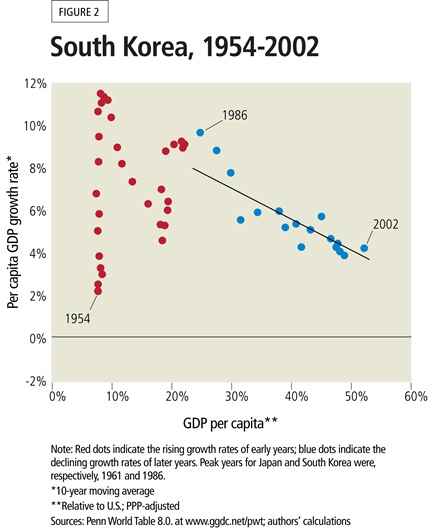Economic Policy Papers are based on policy-oriented research produced by Minneapolis Fed staff and consultants. The papers are an occasional series for a general audience. The views expressed here are those of the authors, not necessarily those of others in the Federal Reserve System.
Executive Summary
China’s impressive economic growth since the 1980s raises the question of how much richer it will become over future decades. Its growing share of the world economy affects other national economies. Understanding the future course of the Chinese economy is therefore important for both fiscal and monetary policymaking in the United States and elsewhere.
Using fundamental growth theory, data from China and from Korea and Japan’s similar “miracle” growth experiences, we provide a suggestive calculation for China’s future per capita income. Our ballpark estimate is that China’s per capita income relative to that of the United States will grow by a factor of two to three over the next half-century.
Introduction1

China’s economy has grown enormously over the past three-and-a-half decades. Its gross domestic product (GDP), the most common measure of economic output, was $10.4 trillion in 2014, making it the world’s second-largest economy—only the U.S. economy is larger.2 This growth has propelled China’s standard of living, formerly one of the lowest in the world, to a level that the World Bank characterizes as “upper middle income.” China’s annual per capita GDP rose from $1,300 in 1980 to $7,700 in 2010, an increase of almost 500 percent.3 4
This impressive performance for a country with 1.3 billion people has engendered a huge volume of research. Most of this work has naturally focused on explaining China’s impressive growth. In this paper, however, we look at China’s future: How rich will China become? Specifically, relative to the United States, how high will China’s per capita income rise?
This question is of policy interest for many reasons. Perhaps the paramount U.S. policy concern is that, all else equal, higher standards of living in China mean a larger Chinese share of the global economy, suggesting that shocks originating there will more strongly buffet the U.S. economy. To the extent that these shocks disturb the path of U.S. employment and inflation, they will influence U.S. monetary and fiscal policymaking.
Of course, estimating future growth of any economy is extremely challenging, so our goal here is to provide a suggestive calculation, a ballpark estimate, drawing from both theory and data. The theory we use is the neoclassical growth model, pioneered by Robert Solow in the 1950s.5 The key mechanism in this model is accumulation of capital, which raises GDP per capita. But as Solow showed, the accumulation of capital in and of itself reduces the rate of future growth. Theory suggests, then, that China’s growth will slow.
Our data are drawn from China’s experience, of course, and also from South Korea and Japan, which experienced their own growth “miracles” in the decades preceding China’s takeoff around 1980. The data complement theory in that the experiences of South Korea and Japan (and many other countries) involved high initial growth that has, in fact, slowed over time to rates similar to or even lower than the U.S. rate. (Indeed, China itself has experienced somewhat slower growth in recent years.)
Through this exercise, blending data and theory, we arrive at a rough estimate that China’s per capita income relative to that of the United States will grow by a factor of two to three over the next half-century.6 In this paper’s conclusion, we discuss assumptions that underlie this forecast and how it might vary if the assumptions are altered.
Background theory and data
As mentioned, the theory that motivates our calculation is the neoclassical growth model, pioneered by Solow and developed by others over subsequent decades.7 This theory, one of the most important in all of economics, is centered on three ideas. First, capital accumulates in an economy as long as the return to new capital (additional future output) exceeds the alternative use of such resources (such as additional current consumption). Second, owing to diminishing marginal returns (each additional unit of capital produces less output than the previous unit), a growing country is less inclined to sacrifice something today for more of it tomorrow. In other words, all else equal, the economy will choose over time to consume more, and save and invest less. Capital accumulation will therefore slow and eventually stop in the absence of technological progress. Third, technological progress, which is not directly addressed by the model, is the force determining capital accumulation in the first place.
Taken together, these three ideas imply that an economy eventually converges to a “balanced growth” path in which its per capita GDP growth is determined only by systematic changes in technological progress.8
The import of this theory for countries’ actual growth experiences is that, in the absence of technological improvements, diminishing returns to capital accumulation will set in, and a country’s growth rate will decline over time. There is a good deal of evidence supporting this theory. For example, Japan and South Korea experienced impressive GDP growth of their own in the decades preceding and concurrent with China’s growth, and both have experienced diminishing GDP growth rates.9 For example, Japan’s per capita GDP growth rate fell from 6.1 percent on average in the 1950s to 5.4 percent in the 1970s and to 2.2 percent in the 1990s. Similarly, in Korea, per capita GDP growth fell from an average rate of 8.5 percent in the 1980s to 5.8 percent in the 1990s and 3.8 percent in the 2000s.10
This slowdown is illustrated in Figures 1 and 2 for Japan and South Korea, respectively. Each point represents one year, from 1951 (Japan) or 1954 (South Korea) to 2002. The x-axis denotes the per capita GDP relative to the United States in that year. The y-axis denotes the average annual per capita GDP growth rate in the decade including and following that year.11 For both countries, there is a clear pattern that could be described as an upside-down check mark. Initially, both countries grew very rapidly. But, eventually, as their per capita GDPs converged toward that of the United States, their growth rates declined over subsequent decades. In the next section, we show how this slowdown informs our analysis of China’s future per capita income.
Suggestive calculation
Figures 1 and 2 demonstrate that some key “growth miracle” countries have seen their per capita GDP growth rates slow over time as they grew richer and caught up to the United States. The most important assumption in our analysis is that China’s growth will slow at the same rate as South Korea’s and Japan’s. Of course, without a consensus view of the reasons for South Korea’s and Japan’s slowdown, along with a strong understanding of the forces behind China’s growth, we cannot ascertain how good this assumption is.
Nevertheless, there are three hints that this assumption of similar growth paths is plausible. First, as discussed above, the neoclassical growth model predicts that in the absence of steady technological progress, a country’s per capita GDP growth rate should fall over time. In the presence of steady technological progress, the country’s per capita GDP growth rate will fall until it reaches the rate of technological progress. Moreover, steady technological progress is harder to achieve as a country evolves from one that imitates or assimilates existing frontier technologies to one that develops new technologies. Second, no country in the world has been able to sustain growth rates of 7 percent or higher for more than four decades. Third, South Korea, Japan and China are geographically close. They trade a great deal with each other, and both South Korea and Japan invest directly in China. These close economic ties suggest that their growth experiences could be similar.
Figure 3, like Figures 1 and 2 for Japan and South Korea, plots China’s growth experience over five decades. As can be seen, though still quite poor relative to the United States, China has had a very high GDP growth rate. And, there are no signs of a slowdown until the data point labeled 2002, which (because the y-axis plots the average 10-year per capita GDP growth rate) captures the growth rate from 2001 to 2011.
For our calculation, we assume that as of 2011, China’s GDP growth has peaked or will peak soon, as recent data indeed suggest. We further assume that in ensuing years, China will follow Japan’s (or South Korea’s) path—that is, starting from 2011, China will experience the same downward growth trend as those countries. Specifically, for every 1-percentage-point increase in China’s per capita GDP relative to that of the United States, we hypothesize that China’s ensuing per capita GDP growth will decline by 0.162 percent (Japan) or 0.175 percent (Korea).12 In other words, as China’s per capita income catches up to the United States, it will experience slower rates of growth just as Japan and South Korea did. We assume this slowdown continues until China’s per capita growth rate is the same as the U.S. rate.
Figure 4 shows the implications for China’s per capita GDP if it follows either Japan’s or South Korea’s growth trend. In both cases, China’s per capita GDP reaches a steady state of close to half the U.S. per capita GDP by around 2061. This means China’s economy will continue to catch up to the U.S. economy for another several decades, but will eventually stop gaining before it becomes as rich (in per capita GDP) as the United States. This is not surprising, as both South Korean and Japanese economies have slowed considerably, and in Japan’s case, appears to have hit a steady state at about three-fourths of U.S. per capita GDP.
Conclusion
Motivated by neoclassical growth theory, we used the “growth miracle” and slowdown experiences of South Korea and Japan to provide a suggestive calculation for how rich China will become relative to the United States.13 Our calculation implies that China will improve its per capita income at a faster pace than that of the United States for about the next 45 years. By around 2061, it will reach close to half of the U.S. income per capita. While China’s income per capita relative to the United States will more than double from today, its absolute income per capita will increase by much more, by about a multiple of five.
While we think our exercise is well-grounded in theory and actual country experiences, we recognize that there are major differences between the economies of South Korea and Japan, on the one hand, and the economy of China, on the other hand. South Korea and Japan are small compared to China and, hence, were able to join the global economy in a relatively seamless way. By contrast, as an economy with close to 20 percent of the world’s population, China has had, and has needed to have, a large impact on global production and prices in order to generate high rates of GDP growth and improvements in its standard of living.
In addition, China’s economic institutions, policies and economic organization are all quite different from their counterparts in South Korea and Japan during their growth miracle periods. However, for the purposes of our exercise, the most important dimension is how institutions and policies in China change going forward. To the extent they evolve similarly to the way they evolved in South Korea and Japan, our exercise provides a useful projection on the extent of China’s convergence to U.S. per capita GDP.
Endnotes
1 Tim Kehoe gave very helpful comments. This paper updates and extends previously unpublished work by Yi and Behzad Kianian on China’s per capita income and GDP. The authors are grateful for Kianian’s contributions in the previous work. Also see Kianian and Yi (2009).
2 Source: International Monetary Fund; National Bureau of Statistics (China); authors’ calculations.
3 The most widely used measure of standard of living adjusts a country’s GDP for price differences across countries (purchasing power parity (PPP) adjustment). This paper uses PPP-adjusted GDP unless otherwise stated.
4 Source: Feenstra et al. (2013), Penn World Tables (PWT 8.0). These numbers are drawn from “rgdpo,” which is output-side real GDP at chained PPPs (in mil. 2005US$).
5 See Solow (1956, 1957)
6 We use the PWT 8.0 measure “rgdpo,” which is output-side real GDP at chained PPPs (in mil 2005US$).
7 See, for example, Cass (1965) and the references in Acemoglu (2009).
8 In the absence of technological progress, the economy reaches a steady state with zero per capita GDP growth. In the presence of (long-run) technological progress, the economy can reach a balanced growth path in which capital, GDP and consumption all grow at the same rates. However, the conditions for the neoclassical growth model to yield a balanced growth path are more stringent than the conditions for the model to yield a steady state. In our calculations below, we assume such stringent conditions hold.
9 This is true for other countries as well, including Singapore, Taiwan, Ireland and Malaysia.
10 Source for Japan and South Korea: PWT 8.0, output-side real GDP at chained PPPs. The growth rates are logarithmic (log) growth rates.
11 Specifically, the y-axis for year t gives the (log) average annual growth rate between year t-1 and year t+9.
12 The 0.162 percent figure for Japan is estimated by regressing the 10-year moving average growth rate on GDP per capita relative to the United States for Japan between its 1961 growth rate peak and 2002. The 0.175 percent figure for Korea is calculated similarly, using data between its 1986 peak and 2002.
13 Other papers, using different approaches, have also argued that China’s growth will slow down. See Pritchett and Summers (2013) and Kehoe and Ruhl (2010).
References
Acemoglu, Daron. 2009. Introduction to Modern Economic Growth. Princeton University Press, Princeton, N.J.
Cass, David. 1965. “Optimum Growth in an Aggregate Model of Capital Accumulation.” Review of Economic Studies 32: 233-40.
Feenstra, Robert C., Robert Inklaar and Marcel P. Timmer. 2013. “The Next Generation of the Penn World Table.” Available for download at www.ggdc.net/pwt.
Kehoe, Timothy J., and Kim J. Ruhl. 2010. “Why Have Economic Reforms in Mexico Not Generated Growth?” Journal of Economic Literature 48: 1005-27.
Kianian, Behzad, and Kei-Mu Yi. 2009. “China’s Emergence as a Manufacturing Juggernaut: Is It Over-Stated?” Federal Reserve Bank of Philadelphia Business Review, Fourth Quarter.
Pritchett, Lant, and Lawrence Summers. 2013. “Asiaphoria Meets Regression to the Mean.” In Reuven Glick and Mark Spiegel (eds.) Prospects for Asia and the Global Economy. Federal Reserve Bank of San Francisco.
Solow, Robert M., 1956. “A Contribution to the Theory of Economic Growth.” Quarterly Journal of Economics 70: 65-94.
Solow, Robert M., 1957. “Technical Change and the Aggregate Production Function.” Review of Economics and Statistics 39 :312-20.










